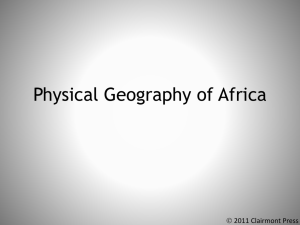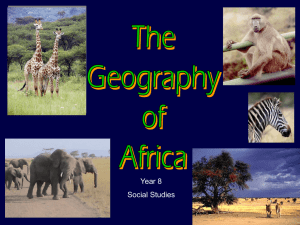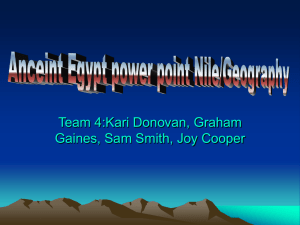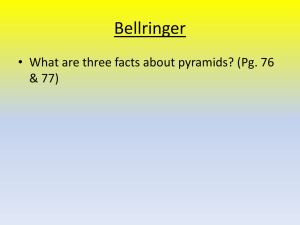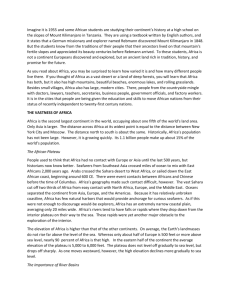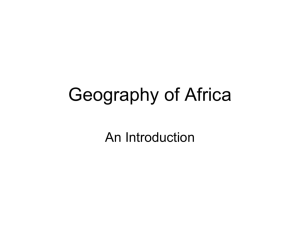AFRICA: Physical Features Chapt 19, Sect 1 What are the four
advertisement
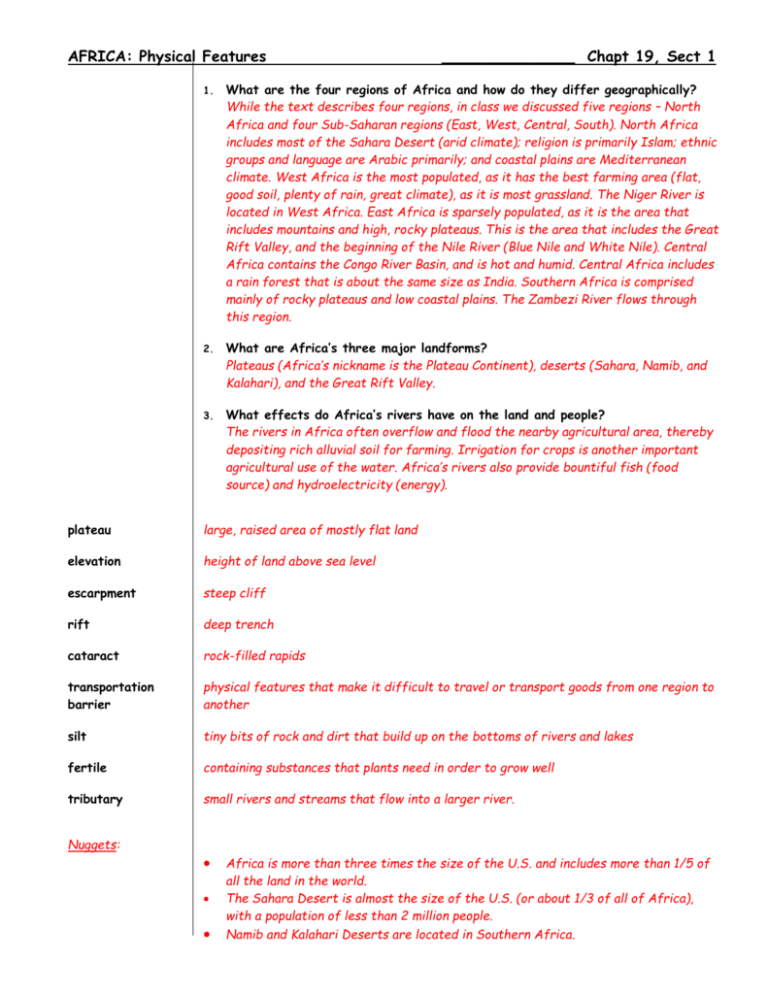
AFRICA: Physical Features ______________ Chapt 19, Sect 1 1. What are the four regions of Africa and how do they differ geographically? While the text describes four regions, in class we discussed five regions – North Africa and four Sub-Saharan regions (East, West, Central, South). North Africa includes most of the Sahara Desert (arid climate); religion is primarily Islam; ethnic groups and language are Arabic primarily; and coastal plains are Mediterranean climate. West Africa is the most populated, as it has the best farming area (flat, good soil, plenty of rain, great climate), as it is most grassland. The Niger River is located in West Africa. East Africa is sparsely populated, as it is the area that includes mountains and high, rocky plateaus. This is the area that includes the Great Rift Valley, and the beginning of the Nile River (Blue Nile and White Nile). Central Africa contains the Congo River Basin, and is hot and humid. Central Africa includes a rain forest that is about the same size as India. Southern Africa is comprised mainly of rocky plateaus and low coastal plains. The Zambezi River flows through this region. 2. What are Africa’s three major landforms? Plateaus (Africa’s nickname is the Plateau Continent), deserts (Sahara, Namib, and Kalahari), and the Great Rift Valley. 3. What effects do Africa’s rivers have on the land and people? The rivers in Africa often overflow and flood the nearby agricultural area, thereby depositing rich alluvial soil for farming. Irrigation for crops is another important agricultural use of the water. Africa’s rivers also provide bountiful fish (food source) and hydroelectricity (energy). plateau large, raised area of mostly flat land elevation height of land above sea level escarpment steep cliff rift deep trench cataract rock-filled rapids transportation barrier physical features that make it difficult to travel or transport goods from one region to another silt tiny bits of rock and dirt that build up on the bottoms of rivers and lakes fertile containing substances that plants need in order to grow well tributary small rivers and streams that flow into a larger river. Nuggets: Africa is more than three times the size of the U.S. and includes more than 1/5 of all the land in the world. The Sahara Desert is almost the size of the U.S. (or about 1/3 of all of Africa), with a population of less than 2 million people. Namib and Kalahari Deserts are located in Southern Africa. AFRICA: Physical Features NOTE TAKING Physical Features Sahara Desert Plateaus ______________ Chapt 19, Sect 1 North West X Zambezi River X X South X X X X Congo River Niger River Central X Great Rift Valley Nile River East X X X Nuggets (continued): Each of the five regions in Africa has mountains, but the highest area is in East Africa. In East Africa you will find Mt. Kilamanjar, the highest peak in Africa. Great Rift Valley was formed millions of years ago when the continents pulled apart. Most of Africa’s major lakes are located in or near the Great Rift Valley. Africa’s four major rivers carry water from the mountains and high plateaus to the sea. The rivers are useful for traveling, but cataracts (rock-filled rapids) make them unacceptable for shipping. o Nile River: Longest river in the world; Blue Nile (beginning in Uganda) and White Nile (beginning in Ethiopian highlands) are the tributaries that form the Nile River; begins in East Africa, flows through North Africa, empties into the Mediterranean Sea; while most rivers flow toward the Equator, the Nile flows away (to the north) instead, as the land is higher in the south and the river flows toward lower lands in the north; regular flooding allowed rich, alluvial soil to blanket the area near the river, making it a rich farming area (in the desert!); in the 1960s, the Egyptian government built the Aswan High Dam to control flooding and to create hydroelectricity for its major cities. o Congo River is the second largest river in Africa; Central Africa; flows to the Atlantic Ocean; hundreds of tributaries flow into the Congo River Basin (just like the Amazon River Basin); creates a hot, humid climate for Africa’s rain forest (which is about the same size as India). o Niger River is the third largest river in Africa; West Africa; flows to the Atlantic Ocean; provides water for farms throughout West Africa, the richest farming area. o Zambezi River is the fourth largest river in Africa; begins in Central Africa, but flows through Southern Africa; flows to the Indian Ocean; forms the borders of six countries; Victoria Falls is located along the Zambezi River; river is also used for hydroelectricity. _______________________________________________________________________________ SUMMARY: Africa is a huge continent with a variety of regions and physical features that affects how people live and work in different regions.


